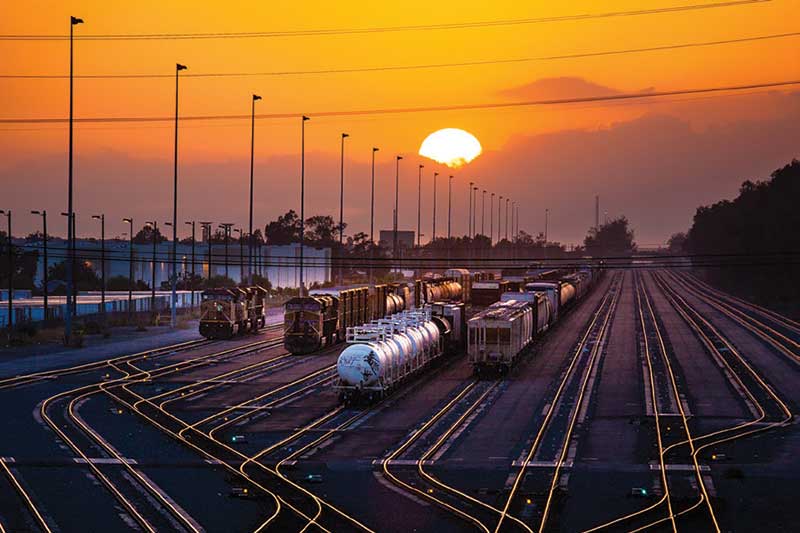Supply Chain Currents: A railroad conundrum
Uncover the True Story of What Happened in the Recent Catastrophic Derailment of Norfolk Southern in Ohio with Insightful Analysis from an Expert With More than 50 Years of Supply Chain, Logistics and Freight Transportation Experience.
With more than 50 years of supply chain, logistics and freight transportation experience on my resume, taking on a monthly column about what’s happening in our world is actually a new adventure for me.
Indeed, the pandemic provided a good illustration on how brittle and complex global supply chain networks are, so there’s a wide swath of subjects for this column, which I intended to start exploring this month. Then Norfolk Southern had a catastrophic derailment in Ohio, which has been front-page news since it happened on February 3.
When asked for my take on the derailment by Jim Hagen, retired CEO of Conrail, I said I thought a variety of interest groups were using this incident to beat the drum for their favorite cause.
- Labor argued that this was evidence of why a two-man crew mandate was required—even though there were three men on this train.
- Some have picked away at the braking system. A New York Times op-ed piece referred to it as “Civil War-era” braking technology (George Westinghouse, 1868), pointing out that higher-tech electronic braking was available, yet the railroads fought it.
- It has become a political shuttlecock, being batted back and forth as the partisan politician’s hurl accusations at each other.
- And, there have been a number of aspersions cast about corporate greed being the root cause, stemming from Precision Scheduled Railroading (PSR) and the related reductions in operating costs through job cuts and reduction of infrastructure, such as closing yards and terminals.
PSR is a term coined by the late Hunter Harrison, while CEO of CN, as a way to drive down the operating ratio (expense as percent of revenue). Wall Street loved it so much that most carriers followed suit in some form or other. In turn, operating ratios dropped down to record lows and stock prices reflected better earnings. But, service suffered and shippers complained.
Bill Stephens, a columnist with Trains Magazine wrote in his analysis: “Before he retired in 2019, BNSF Railway executive chairman Matt Rose warned that the other Class I railroads were inviting regulatory risk by adopting precision scheduled railroading, reducing service, and demarketing some types of traffic in pursuit of higher profits.”
So, what does all this mean? Almost certainly there will be an impact, as there always seems to be a surge in government spending and regulation when there’s a disaster (e.g., Mississippi bridge failure, Hurricane Katrina, this incident, et al).
Already, there’s movement in Congress.
According to a recent report in Progressive Railroading, two Ohio senators announced they will introduce the Rail Safety Act of 2023. The bill would require various rail safety improvements, the specifics of which have yet to be revealed, but presumptively
adding more regulations.
All of this comes at a cost, which typically gets translated into greater expense for shippers and end-use customers. Of course, when it comes to matters of safety, cost-benefit economics are a difficult discussion.
The mandate for two-man crews also makes the industry less-competitive in the face of automated vehicles and self-driving trucks, which will have a significant labor cost advantage as that capability expands. Technology exists for autonomous train operations (e.g., Australia and other places), but the political and social obstacles in the United States have yet to be overcome.
So, change is again afoot—with outcomes that will ripple down the supply chain for many years to come.

Article Topics
Norfolk Southern Corp. News & Resources
Supply Chain Currents: A railroad conundrumLatest in Logistics
LM Podcast Series: Assessing the freight transportation and logistics markets with Tom Nightingale, AFS Logistics Investor expectations continue to influence supply chain decision-making The Next Big Steps in Supply Chain Digitalization Under-21 driver pilot program a bust with fleets as FMCSA seeks changes Diesel back over $4 a gallon; Mideast tensions, other worries cited Four U.S. railroads file challenges against FRA’s two-person crew mandate, says report XPO opens up three new services acquired through auction of Yellow’s properties and assets More LogisticsSubscribe to Logistics Management Magazine

Find out what the world's most innovative companies are doing to improve productivity in their plants and distribution centers.
Start your FREE subscription today.
April 2023 Logistics Management

Latest Resources
















